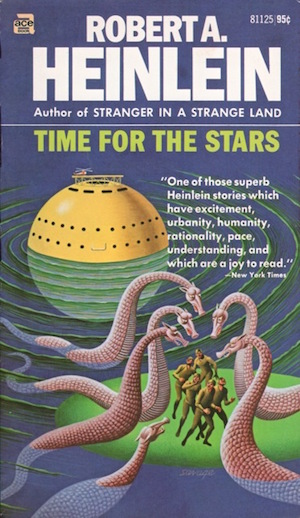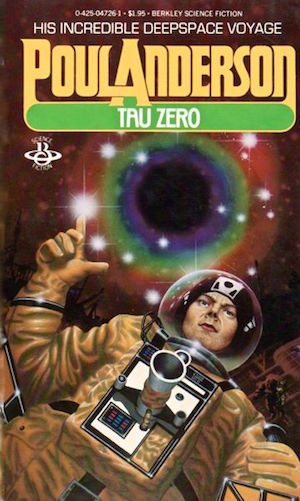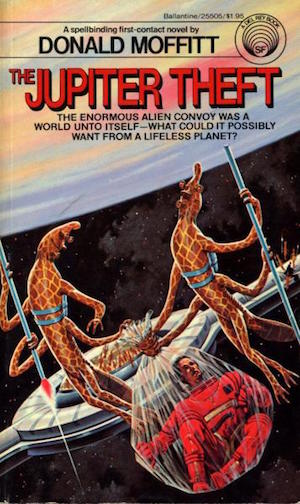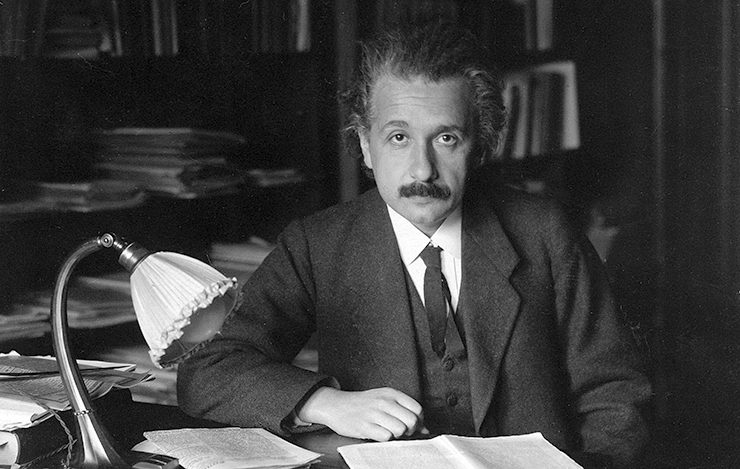I gravitate towards certain SF sub-genres, such as stories featuring relativistic travel. I’ve encountered a fair number of such sub-genre books in which it is clear that the authors did not, emphatically NOT, understand relativity. This article features novels in which authors have wrestled with Mr. Einstein and lost three falls out of three.
As you know, there are two essential foundations of relativity. The first is that the laws of physics are the same everywhere. The second is that the speed of light is invariant regardless of one’s frame of reference. Every single SF novel in which reference is made to time as measured by the ship as “subjective” and time measured by the Earth “objective” is wrong: everyone’s clocks are right, even if they don’t agree with each other.
Now that we are all sufficiently edified, let us proceed…

Robert Heinlein: now there’s a hallowed SFnal name. Whatever else one my think about his books, one must admit that he did not grasp relativity. When he goes into any detail on the matter, it becomes really, really clear that he didn’t understand. Shocking, given that he was born two years (1907) after the publication of Einstein’s seminal paper (1905). I mean, he had time to read up on it!
In Time for the Stars, instantaneous telepathy facilitates communication between twins across interstellar distances. Relativistic travel complicates the issue:
At three-quarters the speed of light he complained that I was drawling, while it seemed to me that he was starting to jabber. At nine-tenths of the speed of light it was close to two for one, but we knew what was wrong now and I talked fast and he talked slow.
The situation should be symmetric: both twins should perceive the other as slowing down. That said, Heinlein has an out here because “instant” communication breaks special relativity. The explanations of just how instantaneous telepathy works makes it clear that in Heinlein’s narrative, there’s a preferred frame of reference. Oh no! Luminiferous ether!
A far more apt example comes from Farmer in the Sky. Farmer does not feature near-light-speed travel, but it does have a remarkable discussion on the subject:
“Mr. Ortega, admitting that you can’t pass the speed of light, what would happen if the Star Rover got up close to the speed of light—and then the Captain suddenly stepped the drive up to about six g and held it there?”
“Why, it would—No, let’s put it this way—” He broke off and grinned; it made him look real young. “See here, kid, don’t ask me questions like that. I’m an engineer with hairy ears, not a mathematical physicist.” He looked thoughtful and added, “Truthfully, I don’t know what would happen, but I would sure give a pretty to find out. Maybe we would find out what the square root of minus one looks like—from the inside.”
The correct answer is “the ship would incrementally approach the speed of light but it would still never reach it or exceed it.” Mr. Ortega is confused here because he’s familiar with how velocities would add up under Newton—which is not how it would work at close to light speed.
According to Newton if something moving at speed u is accelerated by speed v, the result is simple addition: u + v. Einstein (and observation from the real world) says velocities add as (u + v)/(1+uv/c). At velocities much less than light, this produces results close enough to Newton not to matter. But it means one can only approach the speed of light. For example, imagine a starship moving at 0.9 C that is suddenly accelerated by another 0.9 C1. Newton says the final velocity would be 1.8 C. Einstein (and experimental results) say the final velocity is ~0.9945 C.

Poul Anderson’s Tau Zero is rightly considered a classic of the Bussard Ramjet genre of science fiction. That said, there are some eyebrow-raising passages of physics tomfoolery, not least of which are the crew members’ convictions regarding their acceleration, and this claim regarding the behavior of the ship sufficiently high speeds:
“I know the figures. We are not as massive as a star. But our energy—I think we could pierce the heart of a sun and not notice.”
From the Leonore Christine’s perspective, they could regard themselves at rest while stars slam into them at a hair less than light-speed, so I am pretty sure whatever emerged on the far side of the star would not be an intact starship. Anderson studied physics in university so I imagine he knew better. This detail is either characterization (such claims come from a crew desperate to believe their struggle means something, not the omniscient narrator) or it’s one of Anderson’s plot-enabling fudges, like the acceleration-compensating fields that can only be generated when passing through the interstellar medium at very high speeds, or the manner in which it’s possible to survive the collapse of a universe by steering one’s ship away from the crunch. Anderson didn’t want to write a book where the ending was “and then everyone died in the interval between one neuron firing and the next.”

Mary Doria Russell’s The Sparrow wasn’t trying to be hard SF, which is just as well. There really is no detail concerning near-light-speed travel (aside from the inability to reach or exceed the speed of light) that the novel gets right: relativistic effects become noticeable at much smaller relative speeds than they should, and the time it takes her starships to reach Alpha Centauri is wrong as well.

Donald Moffitt was part of a cohort of SF writers first published by Del Rey that I think of as “Niven-like.” That is, I suspect that Del Rey published them in the belief that readers who liked Niven’s fiction would like Moffitt’s (and Hogan’s and McCollum’s and others). Worked for me! I snapped up The Jupiter Theft on sight. Moffitt made a curious mistake in The Jupiter Theft: he used strictly Newtonian equations to calculate the product of acceleration, while applying relativistic calculations to the result. As a consequence, he seems to have firmly believed that because 300,000,000 m/s ÷ 10 m/s/s = 30,000,000 or almost exactly a year, space craft accelerating at one gravity could get arbitrarily close to the speed of light in just a year. Because velocities don’t quite work that way, the actual answer is closer to 0.77 C.
(Moffitt’s confusion about physics blinded me to the effort he put into making his aliens alien.)
Moffitt’s orientalist space-opera duology, The Mechanical Sky, delivered further confusion. The starfarers of the future know that for some reason spacecraft accelerating away from the Solar System mysteriously vanish at the 40 LY. It turns out that there’s a simple explanation: as spacecraft approach the speed of light, they gain mass and 40 LY happens to be where a spacecraft accelerating at 1-g gains so much mass it collapses into a black hole!2 To quote the Justice League’s Flash in a quite different context, there are so many reasons why that shouldn’t have worked, not least of which is that of course the rockets are at rest with respect to themselves: from their perspective, their clocks are normal, their measured dimensions are the same as they ever were; it’s the rest of the universe that is subject to relativity’s curious (and experimentally verified) effects.
It’s a curious thing that Special Relativity has been around for most than a century and General Relativity almost as long, but most of us still have trouble wrapping our minds around it (and some remarkable people refuse to accept them as useful models at all). Still, I’d rather see SF authors try and fail than never try at all.
In the words of Wikipedia editor TexasAndroid, prolific book reviewer and perennial Darwin Award nominee James Davis Nicoll is of “questionable notability.” His work has appeared in Publishers Weekly and Romantic Times as well as on his own websites, James Nicoll Reviews and Young People Read Old SFF (where he is assisted by editor Karen Lofstrom and web person Adrienne L. Travis). He is surprisingly flammable.
[1]This would be very hard on the crew. Thought experiment fatality rates are often extremely high, with the possible exception of the well-known Schrödinger’s cat experiment.
[2]Enblackholeification is a crucial plot point, so if you’re planning on tracking down the Moffitt novels, do not read the sentence for which this is a footnote.















I always liked EE “Doc” Smith’s answer to relativity: “Einstein got it wrong, you can go faster than light”
And of he went…..
>Every single SF novel in which reference is made to time as measured by the ship as “subjective” and time measured by the Earth “objective” is wrong: everyone’s clocks are right, even if they don’t agree with each other.
Well, it’s wrong in one sense, but in the sense that, to make sense of reality, words like objective and subjective would probably be used with regard to a particular reference point (Earth, usually) it makes perfect sense. That is, PEOPLE would almost certainly say, for instance, that Astronaut Bob only lived 3 subjective years while 10 objective years passed on Earth. Because that’s how it seems. (For larger galactic empires it gets more complicated but many still could easily have a ‘standard’ that they calculate differences to.)
So you might say it’s objectively wrong, but subjectively correct.
Ian @@@@@ 1 – you beat me to it! Was about to bring up Triplanetary (a novel I just enjoyed reading for the first time a few weeks ago…)
Nominated for jeers and ballistic expired produce: Flying to Valhalla by Charles Pellegrino, where susceptible individuals get precognitive nightmares when they’re traveling at relativistic velocities. (Plus, the book is the same sort of disgusting pæan to preemptive genocide as The Three Body Problem et seq.)
Catherine Asaro’s books bases a lot of its space combat on the peculiar effects of relativity but I don’t actually know if it’s a reasonable extrapolation or just weirdness
The _Bobiverse_ books deserve a special shout-out for this.
Mostly, relativity is handled pretty well, but in one case, 2 Bob’s (you’ll have to read the books for that to make sense – it’s worth it!) are both heading towards a target at a VERY high fraction of c (from opposite directions).
They can’t talk to the rest of the universe due to time dilation (I’m not objecting to the FTL comms here, although of course that doesn’t make sense), but CAN talk to each other since their clocks are in sync since they’re moving “at the same speed” (even though relative to each other, they’re moving at an even higher fraction of c since they have opposite velocity vectors).
At three-quarters the speed of light he complained that I was drawling, while it seemed to me that he was starting to jabber. At nine-tenths of the speed of light it was close to two for one, but we knew what was wrong now and I talked fast and he talked slow.
The situation should be symmetric: both twins should perceive the other as slowing down.
No, this is wrong. Clearly this is a description of communication between two people, one of whom is accelerating. You can tell because his speed keeps changing.
Special relativity is only applicable to inertial systems – situations without acceleration.
If you have one person accelerating and the other not accelerating, the situation isn’t symmetrical – hence how you can have asymmetrical situations like the twin paradox, where one twin definitely is younger than the other.
If you had a magic box that allowed you to talk instantaneously to your twin while he accelerated to relativistic speeds and you stayed at rest, you would find that he seemed to be slowing down, and he would find you seeming to speed up. Heinlein got this the wrong way round.
@2, so what you’re saying is that we’re going to find that many of the truths we cling to depend greatly on our point of view?
In an earlier Tor.com discussion of Time for the Stars, Gregory Benford pointed out that Heinlein got it right:
https://www.tor.com/2009/10/26/the-identical-twin-paradox-robert-heinleins-lemgtime-for-the-starslemg/comment-page-1/#comment-66445
@7 — I think Heinlein had it the right way round? The narrator is the one on the accelerating ship, so the “he” who complained about drawling is the twin who stayed back on Earth.
Putting a spoiler warning in a footnote is rather audacious, I daresay.
Thanks for the interesting read.
*Nods and pretends he understands the discussion going on *
#5, note that Asaro is a professional physicist. If she wanted the relativity to be right, it very likely is.
While I love the series, the “Honorverse’ drives me nuts when it comes to general relativity, etc. Weber has thrown in concept of allowed FTL through “hyperspace”… OK… one impossible thing to get the stories to work… but FTL detection of gravitational pulses through normal space? Ummmm…. no! All gravity waves travel at c just like photons.
Doc Smith’s explicit declaration of independence from Einstein is in the Skylark universe, not the Lensman universe — in The Skylark of Space, after the runaway engine incident, when they’re trying to figure out where they are and getting nonsense answers, the conversation is:
(And this book was published in 1928, believed to have been written at least 10 years earlier than that. So, actually before much experimental verification of relativity.)
@14 I’m pretty sure Weber cheats with his gravitrics, too. They aren’t detecting normal space gravity waves but the effects of impellers on the alpha wall. So he’s using the same FTL hack for comms and sensors as he is for travel
And when he built his handwaving, I don’t think we had proof gravity was STL. Hasn’t it only been in the last decade or so that we’ve had observational proof that gravity isn’t FTL?
re #14 and Weber having gravity waves go faster than c: Yeah GR doesn’t allow that, but then I think GR doesn’t allow gravity fields that appear and disappear with the flick of a switch in the first place. Artificial gravity is problematic in all sorts of ways well beyond the gravitational wave propagation speed bit.
Have any experiments actually measured the propagation speed of gravity waves?
I hesitate to mention it (okay not really) because it’s not so much relativity it gets wrong, although I’m sure it gets that wrong in there somewhere, and they sort of rely on imagined up theories of space travel, but Borrowed Tides by Paul Levinson is one of the most jaw-droppingly bad science fiction books I’ve read published from Tor.
As I recall, they go on a fairly conventional journey to another star (again, they probably got relativity wrong there but I didn’t do the math and let’s not quibble), except using some ‘tide’ in space that is theorized by the main characters. They get there, do some stuff… then find the ship is going back to Earth. Not from deliberate choice, but just from the same ‘tide’, it’s a two-way flowing river or some junk. Now, that’s not the bad part. The bad part is that they realize that as they’re going backwards, they’re also going BACK IN TIME. Not just the ship, travelling backward to the day the ship launched, but everything on the ship… the food gets restocked, any records they make get deleted (or rather unwritten). Everything except human minds and bodies because they’re special and eventually they come up with a “genetic algorithm” that lets them make records that stick. It also seems to happen in chunks or something so it’s not like food flies out of their bodies and into cans which reseal themselves or something, just the stuff they’ve used gradually reappers. It’s total bonkers nonsense. And not in a good way.
Among other problems with the book is that it seems to also take the theory, “Quantum mechanics is weird, so maybe babies born in space will be able to ALTER REALITY SUBCONSCIOUSLY ON A COSMIC SCALE..” It’s not particularly key to the book. It’s just there.
The worst part is, it’s not even a mildly fun story. That might make me it forgivable, on some levels anyway, but no, the only fun that there is to be had is if you can get some from laughing at the ridiculous lack of science knowledge or thought that went into it. At least, that’s the only enjoyment I got out of it.
FTL gravity is a detail in Anderson’s Technic setting. I wonder if Weber got the idea from there.
@17 I recall observations involving a comet and Jupiter relatively recently. Enough to say for sure that gravity doesn’t work at FTL speeds anyways. There was a bit of chatter about from Weber’s fans was the results of the observation were published.
I think the Farmer in the Sky example is unfair to say Heinlein got it wrong; the character didn’t know the answer. It does not show one way or the other whether Heinlein understands it. Now, maybe you could have argued that the character should have known the right answer, but that’s a separate issue from Heinlein getting relativity wrong.
Also, I agree with ajay @7: my understanding (from Modern Physics taken 25 years ago) is that when one frame is accelerating, the symmetry is broken.
If Mr. Ortega is an engineer in that he has a degree in engineering, he should have the math for this one, and it seems weird that he wouldn’t have thought about it before, and either worked it out or asked someone. I suppose “grinned and said ‘I’d love to try it'” makes a better story moment than “I’m not sure, let me work that out. Come by on Tuesday.”
Time goes more slowly deep in a gravity field, as can be measured by atomic clocks in orbit and not.
Acceleration == gravity.
I’d like someone clever to take me through the accelerating case, rather than just say “anything goes because acceleration”. The way I remember time dilation and the Twin Paradox working was by a story involving instantaneous accelerations with long periods of inertial coasting in between. The trick to the twin (in the paradox, not in Heinlein) coming home younger despite an apparently symmetric set of speeds was that the space twin turned round. But when the rocket was coasting, both twins felt the other was slow when receding, and both felt the other was fast when approaching.
But it seems to me you can break down a constant acceleration (like in Heinlein) into a series of instant accelerations (like in the Twin Paradox) interpersed with inertial situations, and then the symmetry is preserved during those periods. So it’s still the turnaround that does the trick.
Heinlein’s problem is that if he accepts the Twin Paradox result of a younger traveller returning, he needs the asymmetric slowing of speech to happen somewhere. In Einstein it happens because communication can’t be instantaneous. In Heinlein’s story the communication is instantaneous, so the turnaround would not produce any apparent asymmetry.
Thinking about it, those instant accelerations do have an effect, because the space twin experiences them as they happen, and the earth twin sees them after the light has reached earth. So it’s not just the turnaround where everything happens, although the turnaround is what makes the sums add up. But it’s still the case that this only works if you don’t have instant telepathy. Like I said, I need someone clever to take me through the constant or intermittent acceleration case.
I think instant telepathy would amount to communication with your own future, as all the time, you would be chatting to your twin with no slowdown, then one day your astronaut twin says “Okay, I’ve just arrived back on Earth and have met you at the spaceport, and you have a message for yourself: don’t take that promotion and move across the country away from your girlfriend, it was the worst decision of your life”.
I believe Ken MacLeod has that happen in The Stone Canal, where the accelerating space portal amounts to a time portal. (Books are in storage and I hate it so much, I say that several times a week in connection with sf discussions)
And now that I’m thinking about it further (and looking at Minkowski diagrams) yeah, I think Time for the Stars is fundamentally broken because I don’t think the twins would even have the same definition of “instantaneous” once their frames of reference begin to separate.
Which is a shame because I do like that book, and it did actually give me a bit of an understanding of relativity back in the day.
One issue no one’s pointed out, but is found in several of the stories, is that objects going at relativistic speed do NOT gain mass. They gain energy but not mass. So the ships collapsing into black holes because of this supposed mass gain is wrong.
This is a common misconception about relativity because it’s found in many popularizations.
If the twins were quantum entangled, one would assume telepathic communication in both directions would be instantaneous with no relative effects to each twin; however if either twin then physically relayed the telepathic information to any of his / her colleagues (by speaking, writing), the colleague would only receive that information within the colleague’s relative time. The quantum communication (got to TM that) occurs instantaneously to each twin, despite effects of relative time that exists for each twin; the physical time for each is relative to their location / distance / speed, and therefore this is the same relative time shared by their colleagues. The twins quantum entanglement would allow them to communicate within a singular relativity unique to themselves outside of external time and space, yet simultaneously both would exist within their physical relativities (shared with colleagues) defined by time and space.
Of course Einstein did not believe in either quantum entanglement nor telepathy.
@27, objects increase in inertial mass as they travel faster. While there is a difference between inertial mass and gravitational mass, it is still correct to call this mass. Hence the m in e=mc^2. Because of mass-energy equivalency, anything with mass has an equivalent amount of energy, and vice-versa.
@1, there’s also Vernor Vinge’s excuse, where Einstein is absolutely correct around here – but in some other area where the story takes place, things work differently so [pick your favorite SF premise] is totally doable. That also explains why none of the aliens etc. from over there are ever seen over here, because if they crossed over into our boring zone, all their stuff would stop working.
I see what you did there: “I gravitate toward stories …” :)
“Well, it’s wrong in one sense, but in the sense that, to make sense of reality, words like objective and subjective would probably be used with regard to a particular reference point (Earth, usually) it makes perfect sense.”
Daniel Hatch wrote stories where plutocrats travelled between different star systems at lightspeed, ruling over the planetbound masses. He used “banker’s years” and “farmer’s years” to distinguish between the two timescales, which was a nice detail. I imagine a peasant referring to his reference frame as “objective” would be whipped for insolence.
@29 Yes, I’m aware of the equivalence of mass and energy. But that energy does not change the rest mass of objects travelling at relativistic velocity. So they’re not going to collapse into black holes just because they’re going real fast.
@7
Special relativity is only applicable to inertial systems – situations without acceleration.
Special relativity works just fine with acceleration; getting answers just requires calculus (integration) rather than algebra.
For example, see the derivation for the relativistic rocket equation https://en.m.wikipedia.org/wiki/Relativistic_rocket
Acceleration may provide some justification for the time difference between the twins but elsewhere in the book, I seem to recall, twins on ships travelling in different directions and thus accelerating away from each other had no problem reading each other, which I think is an error.
As for myself, I always just try to go along with whatever the author presents to me when things get relativistic. I have a very Newtonian mind, and never did quite grasp all that stuff that happens at the edge of physics. And besides, when relativity enters the tale, authors frequently pull out the improbability drive, and handwavium, and all the other imaginary stuff that allows our heroes to zip from star to star between one chapter and the next.
Relativity, FTL, causality, pick two.
Instant telepathy is FTL, and thus one of relativity or causality must be violated in its presence.
There is no useful quantum communication that doesn’t also involve a classical channel. Measuring an entangled particle does have an effect on the other particle, but not one you can communicate with by itself. It does however provide a nice source of shared randomness, thus enabling “quantum cryptography”, which is really “quantum generation of a one-time pad if you can somehow share entangled particles”. I guess it would be more secure to send stabilized entangled particles through the mail than a one-time pad.
Yes, lots of SF authors including Charles Stross have used “instant quantum”. Doesn’t mean they’re right.
@17
Have any experiments actually measured the propagation speed of gravity waves?
Indirectly through any detection of gravitational waves (first LIGO detections or even the slowly spiralling neutron star binary PSR B1913+16 because you can’t easily make a consistent theory that matches those gravitational waves without them traveling at the speed of light) But if that’s too indirect for you, they were tested spectacularly by the simultaneous detection of a gamma ray burst and gravitational waves https://en.wikipedia.org/wiki/GW170817 ; the timing is so good the speed of gravitaitonal waves must be within about 10^-14 of the speed of light.
As a footnote, the right phrase is “gravitational waves” – “gravity waves” are something else.
It occurs to me that what likely trips up SF authors with regards to relativistic effects probably isn’t the failure to grasp the key aspects like time dilation, mass-energy equivalence, or the Equivalence Principle. Rather, they fumble a couple other subtleties that are more akin to bookkeeping errors, ones that will even trip up trained physicists from time to time if they are a bit lazy in their thinking.
The first is forgetting (or ignoring) that acceleration is the rate of change of velocity which is a vector quantity. In the trivial case of two observers accelerating directly towards or away from each other, i.e. involving only a constant rate of change in speed, any observable effects will be symmetrical between them. However, as soon as the acceleration involves either a spatial component or a variable rate of change in speed, then the symmetry is broken; at most one of the observers could claim to be in an inertial reference frame, and at least one of them must feel a ‘force’.
The second is forgetting (or ignoring) that inertial frames differ not just in the rate at which clocks appear to run but also the zero-point timestamp at which a clock in on frame agrees with a clock in a different frame. In the classic Twin Paradox, it is the mis-synchronization of the traveling twin’s clock—it starts in one frame, transfers to at least one other, and is ultimately compared with a clock in yet a third frame—that does the heavy lifting to explain the phenomenon. And switching from one inertial reference frame to another, even if the latter is moving at the same relative speed (but not necessarily direction), is mathematically equivalent to acceleration. As one accelerates through a series of inertial frames, a series of temporal deficits are accrued in much the same way that Phileas Fogg accumulated a small time surplus each day he journeyed eastward.
“I think Heinlein had it the right way round? The narrator is the one on the accelerating ship, so the “he” who complained about drawling is the twin who stayed back on Earth.”
Ah OK then. For some reason I thought the narrator was on Earth. My mistake.
Incidentally, this post is a very good example of the Dunning-Kruger effect. If you understand relativity very well, like Gregory Benford, you will be confident enough to write book reviews of Time for the Stars and get it right. If you understand it sort of vaguely, like me, you’ll go away and check it and think it over and eventually write a comment. If you don’t understand it at all, you won’t even realise you don’t understand it and will write book reviews cheerfully denying the existence of the twin paradox, and will end up looking a bit of a charlie.
#35. @AlanBrown:
“… I have a very Newtonian mind, and never did quite grasp all that stuff that happens at the edge of physics”
I do realize the self-deprecation here, but relativity being at the edge of physics is like evolution being at the edge of biology.
The Time for the Stars question that’s much more interesting is the telepaths in direct ship-to-ship communication. No one ever seems to talk about them, but it’d make a great example or test problem:
Three ships travel from a common point at .99c along orthogonal paths. What is their time dilation relative to each other?
bad_platypus@21: “I think the Farmer in the Sky example is unfair to say Heinlein got it wrong; the character didn’t know the answer. It does not show one way or the other whether Heinlein understands it. Now, maybe you could have argued that the character should have known the right answer, but that’s a separate issue from Heinlein getting relativity wrong.”
I think that’s so. What we see here is a minor failure on Heinlein’s part, but in characterization rather than science. He’s suggesting that Mister Ortega, a simple country mass-conversion engineer, doesn’t understand relativity. We’re later told Mister Ortega’s greatest value is the ability and willingness to go die in the process of keeping the ship habitable. I get why Heinlein wanted to contrast knowledge versus valor there–it’s a valid point to make–but it’s a little off.
To everyone saying that nothing can travel faster than light….excuse me? Did you all miss the announcement from NASA’s propulsion laboratory? In their particle accelerator, they pushed PHOTONS beyond the speed of light, and for just an instant, a WARP BUBBLE formed, just as described by The Great Bird of the Galaxy, the prophet who showed us so many things that seemed impossible in the 1960s but are commonplace in 2018, GENE RODDENBERRY.
i have to wonder…how much experimental evidence re. relativity existed when Heinlein and Anderson were writing vs. now? Many older SF stories now seem dated in their science and technology. Perceptions, technology and knowledge change. Heck, I remember being taught in a science class in junior high that we were entering an ice age.
I just try to ignore science and technology that is wrong or dated if the story is enjoyable. After all, there are many other parts of today’s science fiction, even if written by knowledgable individuals, that people fifty years down the road may scoff at.
Worse yet, I’ve heard tell that these stories are fictional!
Which books do get it right?
Mendy Sobol’s The Speed of Darkness–A Tale of Space, Time, and Aliens Who Love to Party, is a thoughtful, entertaining novel that correctly addresses special (and general) relativity. As one Physics PhD candidate noted in a review, “A great thing about Darkness—there’s real science in this fiction. Don’t worry, I checked!” It also features aliens who love to party, which may be more likely than the time-honored sci-fi tradition of aliens who want to attack us!
I don’t mind the “objective” versus “subjective” at all. Everyone is likely to live on planets (or habitats) close to the galactic reference frame. We can thus all keep a unified calendrical time – call that objective time. That will inevitably be the time kept by sentient creatures. Timing guys will worry a lot about the 10^-8 differences in frequency rate between star systems (about 1 second every 3 years), the rest of us will not.
Subjective time is NAFAL proper time – effectively, of meaning only to the voyager, as it will depend on both speed and distance. Yes, it’s proper time, and my proper time is just as real as your proper time, but I think that the two terms nicely keep the distinction clear.
@43/Nanci, their warp bubble theory doesn’t have photons moving faster than light. From https://dailygalaxy.com/2018/09/nasa-faster-than-speed-of-light-space-travel-will-warp-bubbles-enable-dreams-of-interstellar-voyages/:
“The bubble would contract space-time in front of the ship, flow over the ship, then expand back to normality behind it. It’s inaccurate to describe the spaceship as moving faster than the speed of light, but rather space-time is moving around the ship faster than the speed of light.”
Ken of NJ @@@@@ 44:
i have to wonder…how much experimental evidence re. relativity existed when Heinlein and Anderson were writing vs. now?
The evidence for special relativity was overwhelming by the 1920s, when physicists working on quantum mechanics began trying to combine the two.
BonHed @@@@@ 49:
Wow, I wasn’t aware the “EmDrive” was also producing warp bubbles and FTL light,[1] in addition to (ridiculously weak) reactionless thrust![2] It’s the flaky/fringe-y gift that keeps on giving….
[1] Apparently based on forum posts in 2015 to “NasaSpaceflight.com”, which is a UK-based online media company that has nothing to do with NASA.
[2] It almost certainly doesn’t produce reactionless thrust.
@42 — I never thought about the inter-ship telepaths until I read this article, but yes, they’re also broken. I don’t think the math would be fundamentally different — a bit more complicated to get the exact figures, maybe, because both the observer and the target are on separately accelerating platforms, but that wouldn’t change the conclusion — each ship would perceive its own passage of time as “normal” and every other ship’s as “slowed”, I think.
@51, yeah, it’s all pretty much bunk. We are a long way away from being able to make anything like it actually work. It requires the use of exotic matter, which we can’t produce, and vast amounts of energy that we can’t produce.
#50, #45 – I thought some parts of the theory of relativity were, while perhaps somewhat widely believed in the ‘20s, not actually tested and verified until much more recent times.
But, even if I am wrong in that belief (I am not a Physicist), I agree with #45 that it is just fiction and meant to be enjoyed as such. Certainly most SF readers don’t quibble about things such as time travel or aliens.
the best treatment of special relativity in SF is “’39” by Queen.
Joe–I agree with you on Queen’s “39.” I think we should also consider Paul Kantner’s “Blows Against the Empire.”
@54: What’s been established more recently are some predictions of general relativity, not special relativity (I do agree that a good story is a good story).
@40.ajay
The Dunning-Kruger effect is in fact much more complicated than that, but most people only read the wikipedia entry, so they never understand it.
;)
I remember The Jupiter Theft fondly! It did indeed have great aliens. (And I’m a total sucker for diamond-hard SF.)
For the record, the Twins Paradox is fully resolved by SR. No need to invoke acceleration; it’s strictly a matter of different frames of reference. Given that second axiom about the invariance of c, time dilation is a geometric necessity!
The one that bemuses me is to imagine two spacecraft flying directly away from each other at, say, 0.6 c. Sure seems as if they’d be separating at 1.2 c, right? Nope. It’s easy to see if you do the math or make a spacetime diagram. Weird that it works that way, but there ya go.
@27 and @33: I’m not sure that matters. Energy is energy, and energy is mass, so if enough of either (or both) is in a small enough area, a black hole results.
This is why we can’t examine below the Planck level. It takes energy to examine small things, and more energy the smaller we look. To look below the Planck length requires so much energy in such a small area, a black hole results (which makes studying the thing we wanted to study difficult).
Some were afraid the energy levels at CERN would result in black holes that would swallow the Earth, ignoring that cosmic ray collisions in the upper atmosphere are way more energetic, and even those are not energetic enough. (Plus the fact that tiny black holes would evaporate really fast through Hawking radiation.)
That said, the amount of energy to turn something ship-sized into a black hole would be… a lot. Probably beyond the capacity of any drive to deliver. No drive can provide more thrust that its mass allows, the ideal would be total conversion of drive mass to thrust, but if that were enough energy/mass, then it would already have collapsed.
wyrdsmythe @@@@@ 60:
An object moving at very high velocity relative to you will not become a black hole. In its own rest frame, it has no extra energy. You are implicitly assuming that our inertial reference frame is privileged over that of the object, but this is not so: the essence of relativity is that the laws of physics are the same in all inertial reference frames.
(Consider the fact that there are an infinite number of reference frames in which you — and everything else that is at rest relative to you — are moving at relativistic velocities. Are you a black hole?)
To be somewhat more technical, whether a mass becomes a black hole depends, in General Relativity, on its stress-energy tensor, which is invariant between coordinate systems. This means that if you calculate its stress-energy tensor in its own rest frame, and its not sufficient to curve space into a black hole, then it won’t do so in any other reference frames. See, for example, this physics.stackexchange answer.
#59, @Wyrd Smythe:
Two objects can’t fly away from each other at 1.2c, of course. That would violate relativity. Nobody in either ship would perceive them as doing so, either. However, if both left Earth at the same time and flew away in opposite directions at 0.6c, someone on Earth would indeed perceive them as separating at 1.2c.
#61, @PeterErwin
Agreed. Note that by relativity, if a particle accelerator launches a proton away from the experimenter at, say, 0.999999999999999999999999999999999999 of c (made up number), in principle enough to collapse it into a black hole, the particle would observe the experimenter moving at that same speed, along with Earth, Sol, the Milky Way Galaxy, etc. So if you allow the black hole collapse effect, the entire universe except the particle would collapse into a black hole. But only when observed from the particle, we inhabitants of that universe would never notice. Seems inconsistent.
(Of course the collapse would take longer than the expected duration of the entire universe in any case due to time dilation. Or would the Schwarzchild radius be so large, containing the entire visible universe, that nobody would even realize we were now in a black hole, since it would contain everything we can ever in principle detect?)
Is this incorrect? “At a relative velocity of ‘v’ time interval at first frame of reference equals time interval at second frame of reference multiplied by the square root of one minus the square of the relative velocity divided by the square of the speed of light. That’s just the special case, of course, for constant speeds…”
That’s Heinlein’s explanation in Time For The Stars.
Roger, it’s correct, but Heinlein’s plot macguffin is incorrect. You can’t communicate with other frames of reference by any other means than, at best, light or something as fast as light. And you can’t measure any other speed, for things that are as fast as light, than the speed of light.
That second fact was the result of the Michelson-Morley experiment, that got everybody thinking something else had to give. Fitzgerald correctly predicted length contraction in the 1880s, not long after the experiment, and Larmor predicted time dilatation in the 1890s, but it took Einstein, in the 1900s, to put together the theory of why these things happen. It’s a bit like Pauli predicting the neutrino; when you’ve got a puzzling observation, it’s not hard to reverse-engineer the arithmetic to find out what would be needed to fix it.
Sorry, went off on a tangent there. The point is, Heinlein’s psychic twins violate either relativity or causality. We strongly conclude, on the basis of a century of experiments, that relativity and causality violate Heinlein’s psychic twins, or at least the plot of his novel about their experiences.
@61: That makes more sense, thanks. I was trying to reconcile kinetic energy, and it wasn’t really working out in my mind. (I do stand by the idea that enough energy in one area will result in a BH.)
The question of instantaneous communication is a violation of relativity, so all bets are off as to the likely effects.
Keep in mind that without acceleration, two bodies in motion relative to each other cannot determine which is moving and which is at rest. Thus the effects on communication between each body would appear identical on each body.
However, fi one body was accelerating and the other was not then the effects would be asymmetrical. This is the solution to the identical twin paradox.